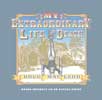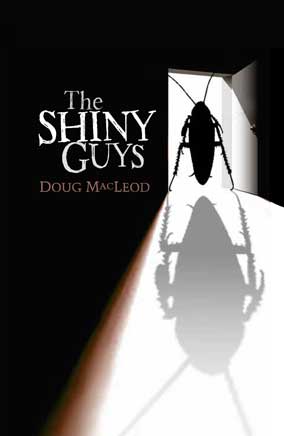
The Shiny Guys
'Wouldn't it be funny if they were real?'
'Shiny red men?'
'What if I were the sane one and everyone else was mad?'
One night, the shiny guys visit fifteen-year-old Colin Lapsley. They don't speak, but Colin can read their thoughts. They want him to pay for the terrible thing he has done. When the shiny guys won't go away, Colin is admitted to Ward 44. There he discovers an alien world, a powerful weapon, a gentle giant, and a girl who may be able to see what he can see. But will Colin be able to defeat the shiny guys before it's too late?
The Shiny Guys is a dark, sometimes funny novel about how fantasy and reality can merge, especially when electricity is involved.
Though I didn't realise, when I wrote The Shiny Guys I was on the verge of having a stroke; a blockage in the veins in my brain starved my cerebrum of oxygen, meaning that thousands of cells died.

I gradually recovered, though I experienced a symptom that inspired the basic idea behind The Shiny Guys. I read in a book by neurophysician Oliver Sacks that some patients, after mental trauma, find it difficult to perceive certain objects to the left or right of their vision. It's best illustrated with a diagram. Here is a pretty basic picture of a cat. I am no artist.
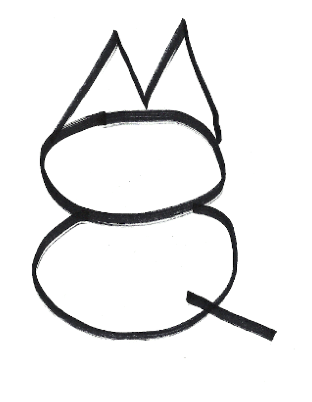
Most patients would have no trouble copying it accurately. Here is a slightly different picture of a cat.
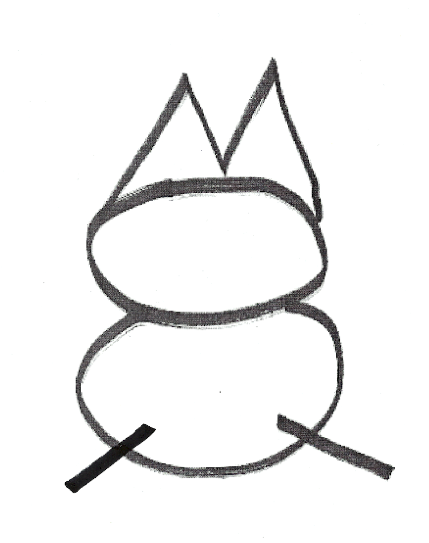
While it's likely that you can see that this new cat has two tails, and would include the extra tail if you were asked to draw a copy of the picture, a patient suffering from left-side neglect might draw the cat with just its right tail, omitting the one on the left. And when the second tail is pointed out to them, they might be genuinely surprised. I wondered what it would be like if the entire world were suffering left-side neglect, only nobody knew. What if there were something lurking on the periphery of our vision that no one ever saw, but that a few gifted people realised was there? It seemed an interesting idea for a science fiction story so I filed it away. I wrote it up as a half-hour TV script and tried to get it produced but with no result, though people did seem taken by the idea of a whole part of the world that only a few people could see.

After my recent stroke, I did suffer a mild form of left-side neglect. Quite a coincidence. I certainly would have passed the 'two-tailed cat' test, but not other, more subtle tests.
The presentation manuscript of The Shiny Guys was completed long before I suffered my stroke (you can read a little about it on my blog if you're interested). One way to go with the story would have been to take the John Wyndham science fiction approach, where a small group of humans united by a potentially life-saving skill unite against a large, usually sinister protagonist.

But I didn't want to write a science fiction novel, as much as I enjoy reading science fiction. (John Wyndham is a particular favourite). At the time I was thinking about the story I was touring schools in Western Australia, as a guest of the Australian Children's Book Council. I rose early most mornings (I was still on east coast time and often found myself wandering around some of the most extraordinary coubtryside at dawn, which looked quite alien to a St Kilda resident like me. I'd also just bought my first iPod and had loaded it with talking books, hence I had a soundtrack to what I was observing. I remember as a teen being fascinated by the fantastic stories of the Czech writer, Franz Kafka.
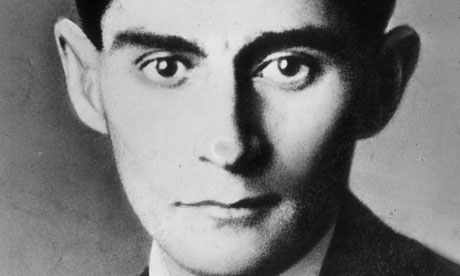
I listened to the entire reading of The Castle, not realising that Kafka had never finished it. In fact, he decided to stop mid-sentence which is a terrible anti-climax after you've spent hours with the main character, 'K', and his attempts to reach the mysterious 'Castle' in which live the controllers of the land that the narrator inhabits. Gradually, Kafka's vision of an unreachable place merged with the phenomenon of left-side neglect about which I'd read, and I thought I might have an interesting tale on my hands. But it was all about abstruse concepts and not, I thought, very engaging for a reader.
The third part of the story turned out to be my own memories of when I was admitted to hospital many years ago suffering acute depression. It was a terrible time, made worse because I knew that people were worrying about me and didn't want to upset people. I ended up in a ward at the Heidelberg Repatriation Hospital, under the care of a psychotherapist and some very dedicated staff, who are not like the ones portrayed in the book. Unfortunately there was a nursing strike while I was there, so I stayed inside for two weeks longer than was probably necessary. But I learned a few tricks for dealing with depression (they're in my other books, but not this one).
The first draft seemed to happen quite quickly. I wrote it while I was writing another book - one of the funny ones that have never achieved much recognition. Writing The Shiny Guys was like a rest break, because writing comedy is incredibly difficult. I submitted The Shiny Guys to my Penguin editor at the same time as 'the funny novel' and was surprised when he preferred it to the one with the jokes. And Penguin decided that The Shiny Guys was the book they wanted to publish, even though it was nothing like my earlier work. In fact I thought it was a rather depressing book (it's hard to write a feel-good book about depression) but they disagreed and thought that some of the other characters in Ward 44 (that was the number of the ward where I was hospitalised) kept the book entertaining enough so that the reader was not bogged down by the darkness of the subject matter.
I don't want to reveal too much of the story, but my main character Colin is deeply depressed because he believes himself to be responsible for the abduction and murder of his much loved younger sister. The potentially controversial part of the novel is that it deals with Electro Convulsive Therapy, which my main character receives, though on a quick reading of the story, this does not become apparent until towards the end. I did not receive ECT when I was in hospital recovering from depression, though friends of mine certainly did. My editor at Penguin was surprised that I had written about ECT in an almost positive way. Everyone's notion of it seems shaped by the references in the book One Flew Over the Cuckoo's Nest by Ken Kesey. But demonising ECT seemed an easy way out, and I had seen cases where ECT did seem to have helped people suffering severe depression. Two of my adult friends have received ECT. I spoke with the writer Barry Dickins about his experience of ECT. He didn't think it had lifted his depression. He writes about it in a book called Unparrelled Sorrow. I have another friend from the world of advertising who was having treatment the same time as Barry, and it certainly seemed to work on him. He had been suicidal, but his outlook had changed after six sessions of ECT, coupled with pharmacological treatment and psychotherapy. It's a serious subject so I've tried to write as honestly as I can. A helpful nurse showed me an ECT room in a psych ward, and described the process in some detail.
'The Shiny Guys' are characters on the very edge of Colin's vision, characters that only he can see, though he is convinced they are real. And if he can see them, perhaps others can too? The story takes place in the real world of Ward 44 and the quite possibly unreal world of Nestor, an alien planet that looks strangely familiar to Colin, a keen fan of science fiction.
It was a strange book for me to write. I hope you enjoy it, and I promise that my next book will have more jokes. There actually are quite a few jokes in this book. Here's a funny passage that was cut:
In the bed opposite Jill sleeps Miriam, the woman who pleats. She can't help herself. If she is anywhere near paper or material she will start pleating. She even pleats during the night. Once I looked in and she was just lying there in her undies. She had pleated the blanket and the sheet so that there was a big concertina strip of Manchester at the end of her bed. She had taken off her pyjamas and pleated them as well. Was Miriam a danger to the world? Can you be a homicidal pleater? I have warned 99 in the library never to lend books to Miriam unless she wants them to come back looking like origami.
But Miriam didn't make the final draft. The book is already 60,000 words long, which seems plenty to me.
There was the usual discord about what we should call the book and how the cover should look. Originally I called the book The Third Tail of the Cat, which I think is a terrible title. My editor at Penguin suggested Ward 44, which I think is also a terrible title. I tried to think of a title that suggested something mysterious and threatening, and finally came up with The Shiny Guys.
I had to rewrite some parts of the novel to accommodate the title change. I also had to argue for the title, since it didn't go down all that well, but I'm happy with it. My friend Dan Verkys came up with a fantastic cover idea of his own:











